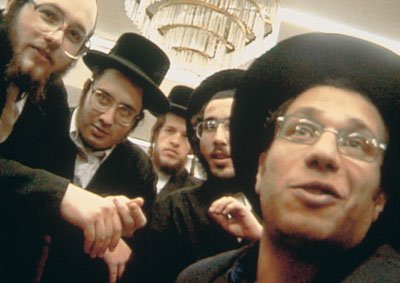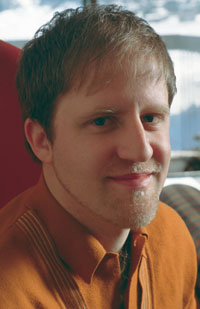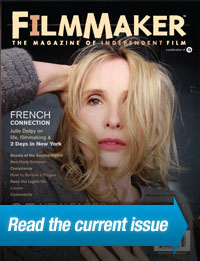UNORTHODOX BEHAVIOR
Bari Pearlman speaks with director Sandi Simcha DuBowski about his documentary portrait of gay Orthodox Jews, Trembling before G-d.
In 1995 Sandi Simcha DuBowski first focused his video camera on gay and lesbian Orthodox Jews living secret and painfully conflicted lives. And while he doggedly convinced his reclusive subjects to appear in his documentary, Trembling before G-d, DuBowski also crisscrossed the globe, creating a new paradigm for indie financing. By forging a collaboration between the Jewish, philanthropic, gay and lesbian, and independent film communities, DuBowski financed a six-year production through support from 24 foundation grants, countless fundraising cocktail parties and the contributions of vendors like Skywalker Sound, which donated an in-kind sound mix. At the same time, he broadened the definition of “documentary filmmaker” by becoming a counselor, therapist and activist for a group of individuals never before given a collective identity by the media.
Now, several months after Trembling before G-d premiered at the 2001 Sundance Film Festival, DuBowski prepares for its U.S. theatrical premiere by continuing to expand his job description. From organizing discussion groups to smuggling TVs and VCRs into the apartments of his cloistered subjects so they can see themselves on screen, DuBowski is redefining the ways in which contemporary doc makers must creatively engage their audiences.
 |
| Mark, far right, at Yeshiva in Israel. |
FILMMAKER: How did this film come about? What made you decide to do a film on this subject?
SANDISIMCHA DUBOWSKI: It was the early 1990s, and I was 24 years old, making videos and organizing against the Christian right wing and the anti-abortion movement for Planned Parenthood. And this forced me to examine my own upbringing. I had moved back in with my parents in deep coastal Brooklyn, where I think the closest gay spot was either the cruising happening under the Brighton Beach boardwalk or the light-’em-up- Saturday Night Fever dance floor in the gay bar in Bay Ridge. So when I first started the film, it was a personal video diary of my experiences as a secular-ish, conservative gay Jew from Brooklyn exploring whether there was homosexuality in the Orthodox world. Everyone laughed when I said I was making a film about Orthodox gay people. They thought it was an oxymoron. But when I started meeting people who were kicked out of their families, thrown out of religious schools, forced into marriages where they were betraying their husbands or wives, it was clear that the film would take on a whole other level of responsibility and accountability.
FILMMAKER: It must have been difficult to first find your subjects and then to get them to consent to be interviewed on camera. How did you go about it?
DUBOWSKI: By this time I was living in Jerusalem, where there was no meeting place for gay and lesbian people besides the park. I would go to the park where Orthodox men would be cruising, and I would pass out flyers for the film. And some of the men would take a flyer under a lamppost and read it, and then they would take out a yarmulke from their pocket, show me, and then put it right back in. I also put an ad in the paper in Israel, and I would get random calls on my mobile phone. Malka and Leah, the Orthodox lesbian couple in the film, found me through this underground “Orthodykes” Internet activity — we communicated through instant messaging and e-mail for about two years before we actually met. And then in order to get the Orthodox and ultra-Orthodox rabbis to be in the film, I had to hide a TV in a box, sneak it up the stairs to their homes so their neighbors wouldn’t see, and show them clips of the film.
FILMMAKER: So it was a long process of gaining the trust of your subjects?
DUBOWSKI: This film is the first mass public voice of a community that has always existed but never had a mass cultural face, and I was using a visual medium [to depict] a community that didn’t want to be seen. That can be really liberating, but also really threatening and frightening for people who have never seen themselves legitimized, valued and taken seriously. I had to overcome a lot of fear from within the community; they would doubt my every move, not trust my intentions, and were afraid of how they would be represented.
FILMMAKER: Do you see this film as community-building, or is it more about giving an existing community a voice?
DUBOWSKI: I was building community as I was shooting. If you add up the thousands of hours I put into Trembling before G-d, a lot of [this time] wasn’t related directly to the [making of the] film. It was sitting with a Hassidic guy who wanted to commit suicide and trying to talk him out of it. Or talking to a guy who wasn’t able to go home because his mother was trying to force him to get married. Or helping someone without a secular education who needed to find a job to write a résumé. There were a lot of people in very deep trouble, and I was — and am — constantly hooking people up with rabbis and therapists.
FILMMAKER: In addition to the silhouetted or shadowed interviews you conducted with your closeted subjects, very striking but obviously dramatized silhouetted scenes of Jewish rituals are woven throughout the film. Why did you choose to create these scenes in an otherwise non-fiction film?
DUBOWSKI: The easy answer to the question of what someone should do if they are gay and Orthodox is that they should just leave the community. So, if I didn’t show why people wanted to be Orthodox, I wouldn’t have been doing my job as a filmmaker. But I couldn’t film on the Sabbath, which is 25 hours of singing, praying, eating, spending time with friends and family, going to synagogue, sleeping, having sex — and is the core of an Orthodox Jew’s week. So we put up a 14-foot screen at the New York University soundstage and invited the community to form its image behind the screen. It was very special because a lot of these people really wanted to participate in the film and they weren’t able to, so this gave everyone a way to do so. We did the blessings over the wine and the bread, and we staged an Orthodox wedding where all the parts were played by gay and lesbian people. At one point there was an Orthodox lesbian who walked in front of a candle, and the candle burns this orange glow into her body as she passes by the flame. And for me, that’s exactly the metaphor of the film —there’s this amazing combination of hiddenness and illumination that the film brings forth.
FILMMAKER: Of all of the many events that have taken place both in the making of the film and in conjunction with its worldwide screenings, which has been the most powerful experience for you?
DUBOWSKI: At Sundance, we organized a Mormon-Jewish-Gay dialogue, which proved that the film resonated beyond Jews, that it really touched anyone who had any experience of faith who felt like an outsider growing up, who came from any community in which he or she didn’t fit. The film speaks to a sense of “broken-ness” and a sense of “outsider-ness,” and that dialogue was really a sharing of the “broken-ness.” Then we had the first ever Shabbat at Sundance, which was trying to glue the pieces back together. And for me it transcended the hierarchy that places like Sundance can be. We created a space in which, for example, Tilda Swinton was sitting next to a gay guy from the Salt Lake City synagogue. Very few people approach the festival and theatrical spaces as having the kind of potential that they have.
FILMMAKER: It is difficult and rare for a documentary to even get theatrical distribution in today’s exhibition market. How were you able to parlay this event-oriented outreach potential you saw into a distribution deal?
 |
| Sandi Simcha Dubowski. Photo: Richard Kern. |
FILMMAKER: At the festival screening where I saw the film, some audience members seemed frustrated by its lack of resolution. What, if any, solutions do you think are possible for people who live in the state of fear and pain you reveal?
DUBOWSKI: The film is designed to put a human face on what has been until now an abstract issue. There has been no voice and no face, and now there’s a David, there’s a Malka, there’s a Mark. And now that we feel sympathy and have experienced their pain, what’s the next step? How do we grapple with this epistemologically? What solution is there? I think the solution will come over time. Rabbi Steve Green-berg, the first openly gay Orthodox rabbi, is pub-lishing a book called Wrestling with God and Man where he starts interpreting the verses on homosex-uality in the Torah and the Talmud. And he wasn’t even out when I met him! We are starting to galvanize Orthodox rabbis, so we have our first screening at an Orthodox synagogue in November in Riverdale. That’s a major, major mile-stone, and who knew it would be happening so fast?
FILMMAKER: Has your subjects’ participation in the film impacted their lives directly in any ways?
DUBOWSKI: Absolutely. Part of the process of filming has been working with people to build their courage and to have them feel that they themselves can be agents of change. The people I filmed with — Mark, Michelle, David, Israel — were brave enough to step forward when hundreds of people wouldn’t. When I met Mark in 1995, he’d been thrown out of seven yeshivas for being gay, he was living with AIDS, and he had been kicked out of his parents’ house and was living in a squat. And he was a flamboyant drag queen who had completely abandoned Orthodoxy. Going back to the yeshivas that kicked him out, going back to Israel where he vowed he’d never return, starting to celebrate holidays again, set him back on a path towards observance; he is now fully Hassidic. He moved back into his parents’ house, he began yeshiva again and his health is good. When I started filming with Michelle four to five years ago, she thought she was the only Hassidic lesbian, and she weighed 250 pounds. Through the process of filming, she was introduced to all these other lesbian women, and she gained a sense of power and a voice. She decided to get her stomach stapled, and she lost 130 pounds. And she’s now writing a book about her life.
FILMMAKER: Did all of your subjects who saw the film approve of it?
DUBOWSKI: Not everyone is happy. Mark is now scared that this film is going to mean that he will get kicked out of yeshiva again. David pulled out of the film at least five times. And some of the rabbis have now said that the film is biased, that it doesn’t show gay people who have fought their homosexuality, gotten married, had kids’ and are doing fine. So there are some [subjects] with whom I’m not speaking, who asked to be withdrawn from the film. But they signed a release form and had full knowledge of what this film was about. You are forging collaborations with people, but at a certain point you have to define a border and say, “You know what, I’m the director, and I am making a final decision here.”
FILMMAKER: In terms of the filmmaking, your editor, Susan Korda, is credited as a creative collaborator as well as the co-director of the silhouette tableaus. How did this collaboration come about?
DUBOWSKI: I needed to find someone to cut a fundraising trailer. When she and I sat down she was just a firecracker of ideas, and I said, “She’s the one.” And then we were in an editing room for 17 months, where we worked very, very closely until she had the smarts and the courage to kick me out of the room! She had a real co-creation role in crafting a narrative-driven film from a 450-hour sprawl of stories. I needed someone who didn’t vilify or romanticize the religious. She’s not sentimental, whereas I’m a total weeper. This film had to deal with people who had erected barriers to protect themselves against further hurt, and a lot of the fear around this film for the community was, “We don’t want to be hurt anymore.” She was excellent and very perceptive at trying to cut through the ways in which people who have been really hurt protect themselves.
FILMMAKER: What’s next for you?
DUBOWSKI: It’s interesting, everyone expects you immediately to move onto another project, but for me, it’s about longevity, and building the success of this film. Yes, I am developing other fiction and non-fiction projects, but at the same time, I’m developing an interfaith project with Robert West and Judith Helfand at Working Films. We’re going to be doing a tour of Christian theological seminaries in the American South with Rabbi Steve Greenberg. I’m also organizing a Buddhist-Jewish dialogue on homosexuality in India. Besides that we’re developing an Orthodox Community Education Project which is centered in Brooklyn, Miami, L.A., London and Jerusalem. We’re trying to form a straight-gay alliance of Orthodox people to develop resources to help the community by using the film as a trigger and a catalyst. Part of that is the outreach TV project, where we will be bringing TVs in hidden boxes to homes in Williamsburg and Borough Park and Crown Heights and will be creating these small, private home screenings for people who can’t go see the film in a theater or don’t have TV. After all, I am using a visual medium [to depict] a community that didn’t want to be seen. I had that TV on my back for the rabbis, and I’m going to throw that TV back on my back to make sure the film reaches the people who it is intended to serve. It’s very labor intensive, but it’s extremely fulfilling.
FILMMAKER: Looking back to the first time you picked up a camera to videotape Mark six years ago, did you have any idea of where the project would lead you?
DUBOWSKI: I feel like sometimes you choose films, and sometimes they choose you. I think there was a glaring need for this film. It’s about 21st-century Judaism. It’s not a Holocaust story, and it’s not about the founding of the state of Israel. It’s about forging a Jewish identity that is different from those twin poles that have, until now, defined contemporary American-Jewish existence. It’s time for new defining moments.
For more information or to contact Sandi Simcha DuBowski, please visit www.TremblingBeforeG-d.com.
VOD CALENDAR


 See the VOD Calendar →
See the VOD Calendar →



